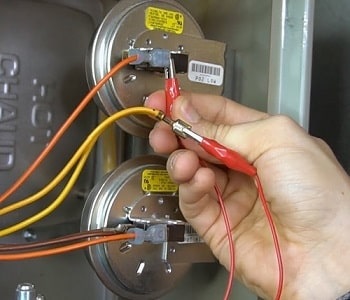Utilizing a manometer and other appropriate tools, you can assess your furnace pressure switch for any signs of trouble. Be sure to shut off power to your furnace prior to opening its access panel for testing purposes.
Your furnace’s pressure switch is designed to prevent back drafting (a leading cause of carbon monoxide poisoning) and detect gas leaks, and it will automatically shut down if it malfunctions.
If you don’t feel comfortable fixing the pressure switch on your furnace by yourself, you should team up with a reputable HVAC service like this company.
Check the Wiring
First, disconnect the power to the furnace by flipping its breaker. For safety’s sake, rubber gloves may be wise in this step since a furnace can be extremely dangerous.
Once the system is no longer powered up, check to ensure the breaker and wires match the voltage rating of the circuit. If too small wires for one breaker but too large for another are used instead, this could result in the pressure switch staying open.
Before disconnecting any wires connecting to the furnace and detaching the hose from the pressure switch, note which ports it connects to to reconnect it later.
Next, unscrew and relocate the pressure switch from the draft inducer motor, screw it into a new one then use a multimeter test to ensure resistance is zero (0) before closing up the access panel and turning back power on.
Check the Flue Pipe
Flue pipes on furnaces that become blocked with debris, ice, or snow may prevent combustion gasses from escaping and thus prevent the pressure switch from moving into its closed position – leading to various other issues, including failure of lighting system components.
Flue pipes are PVC venting systems used to vent exhaust gas from your furnace out through walls or the roof of your house and may become blocked with debris such as leaves, feathers, dirt, or even ice in winter months. When this occurs, it may cause backdraft and potentially toxic carbon monoxide poisoning for you and your neighbors.
To check a flue pipe for blockages, disconnect its wire connectors and use a manometer to take readings of air pressure when running the draft inducer motor. If these readings exceed expectations, the pressure switch could be defective and should be repaired by an HVAC technician immediately.
Check the Hose
If the pressure switch isn’t closing properly, your system cannot vent properly, and potentially lethal carbon monoxide could be in your home. To test for this possibility, shut off power to your furnace and remove its access panel before using your multimeter in resistance (O) or continuity mode to check if 24V of current is running from its control board through safety switches to pressure switches.
Once it reads ohms, reconnect the wires and restore power to the furnace. Next, take care when handling any hot materials when removing hoses leading to switches, as this could potentially make them hot from recent use.
Taking off the hose leading to switches can sometimes unstick them by sucking and blowing gently on it – this may restore normal function; otherwise, a technician should be called in to replace them and may recommend this also to help avoid future problems with them.
Check the Diaphragm
One of the more frequent issues with pressure switches is when their diaphragm becomes stuck or ruptured, preventing it from closing properly and stopping your furnace from starting up.
Luckily, this can often be remedied simply by tapping lightly on its casing.
If this doesn’t do the trick, try searching for blockages.
